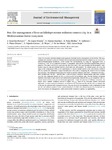Mostrar o rexistro simple do ítem
Post-fire Management Effects on Hillslope-Stream Sediment Connectivity in a Mediterranean Forest Ecosystem
| dc.contributor.author | González-Romero, Javier | |
| dc.contributor.author | López-Vicente, Manuel | |
| dc.contributor.author | Gómez-Sánchez, Elena | |
| dc.contributor.author | Peña Molina, Esther | |
| dc.contributor.author | Galletero Montero, Pablo | |
| dc.contributor.author | Plaza Álvarez, Pedro Antonio | |
| dc.contributor.author | Fajardo-Cantos, Á. | |
| dc.contributor.author | Moya, Daniel | |
| dc.contributor.author | Heras, Jorge de las | |
| dc.contributor.author | Lucas Borja, Manuel Esteban | |
| dc.date.accessioned | 2022-07-08T15:08:16Z | |
| dc.date.available | 2022-07-08T15:08:16Z | |
| dc.date.issued | 2022 | |
| dc.identifier.citation | González-Romero, J., López-Vicente, M., Gómez-Sánchez, E., Peña-Molina, E., Galletero, P., Plaza-Álvarez, P., Fajardo-Cantos, A., Moya, D., De las Heras, J., Lucas-Borja, M. E. (2022). Post-fire management effects on hillslope-stream sediment connectivity in a Mediterranean forest ecosystem. Journal of Environmental Management, 316, 115212. ISSN 0301-4797. https://doi.org/10.1016/j.jenvman.2022.115212. (https://www.sciencedirect.com/science/article/pii/S030147972200785X) | es_ES |
| dc.identifier.uri | http://hdl.handle.net/2183/31149 | |
| dc.description.abstract | [Abstract] Forest fires intensify sediment transport and aggravate local and off-site consequences of soil erosion. This study evaluates the influence of post-fire measures on structural and functional sediment connectivity (SC) in five fire-affected Mediterranean catchments, which include 929 sub-catchments, by using the “aggregated index of connectivity” (AIC) at two temporal scenarios: I) immediately after the fire and before implementing post-fire practices (‘Pre-man’), and II) two years after the fire (‘Post-man’). The latter includes all the emergency stabilization practices, that are hillslope barriers, check-dams and afforestation. The stream system was set as the target of the computation (STR), to be representative of intense rainfall-runoff events with effective sediment delivery outside the catchments. Output normalization (AICN) allows comparing the results of the five basins between them. The sedimentological analysis is based on specific sediment yield (SSY) –measured at the check-dams installed after the fire –, and this data is used for output evaluation. Stream density and slope variables were the most influential factors on AICN-STR results at the sub-catchment scale. Post-fire hillslope treatments (barriers when built in high densities and afforestation) significantly reduced AICN-STR in comparison with untreated areas in both structural and functional approaches. Despite the presence of hillslope treatments, the higher erosive rainfall conditions resulted in higher AICN-STR values in the Post-man scenario (functional approach). A positive and good correlation was found between the measured SSY and the AICN-STR changes due to the post-fire practices and vegetation recovery, showing the good correspondence of the computation results and the real sediment dynamics of the studied catchments. Overall, AICN demonstrated to be a useful and versatile tool for post-fire management, which needs further research to optimize its applicability. | es_ES |
| dc.description.sponsorship | The authors thank the Regional Government of Castilla-La Mancha (Junta de Comunidades de Castilla-La Mancha) for supporting the study and providing information about the undertaken measures in the burned area. This study was supported by funds provided to the VIS4FIRE Spanish R&D project (RTA 2017-00042-C05-00) co-funded by the “Instituto Nacional de Investigación y Tecnología Agraria” (INIA) and FEDER programme. This study was done in the frame of the European Cooperation in Science and Technology (COST) action CA18135 ‘FIRElinks’ (Fire in the Earth System: Science & Society). J. González-Romero holds a postdoctoral contract supported by the European Social Fund (ESF, EU). The authors declare no conflict of interest. E. Peña holds a scholarship (2020-PREUCLM-16032) from the UCLM and the European Social Fund (FSE). Pedro Antonio Plaza Álvarez holds a predoctoral fellowship from the Spanish Ministry of Education, Culture and Sport (FPU16/03296) | es_ES |
| dc.description.sponsorship | Universidad de Castilla-La Mancha; 2020-PREUCLM-16032 | es_ES |
| dc.language.iso | eng | es_ES |
| dc.publisher | Elsevier | es_ES |
| dc.relation | info:eu-repo/grantAgreement/AEI/Plan Estatal de Investigación Científica y Técnica y de Innovación 2017-2020/RTA2017-00042-C05-03/ES/Vulnerabilidad integral de los sistemas forestales frente a incendios: implicaciones en las herramientas de gestión forestal "VIS4FIRE"/ | |
| dc.relation | info:eu-repo/grantAgreement/MECD/Plan Estatal de Investigación Científica y Técnica y de Innovación 2013-2016/FPU16%2F03296/ES/ | |
| dc.relation.uri | https://doi.org/10.1016/j.jenvman.2022.115212 | es_ES |
| dc.rights | Atribución-NoComercial 4.0 Internacional | es_ES |
| dc.rights.uri | http://creativecommons.org/licenses/by-nc/4.0/ | * |
| dc.subject | Forest fire | es_ES |
| dc.subject | Post-fire management | es_ES |
| dc.subject | Sediment connectivity | es_ES |
| dc.subject | Hillslope erosion | es_ES |
| dc.subject | Wildfires | es_ES |
| dc.title | Post-fire Management Effects on Hillslope-Stream Sediment Connectivity in a Mediterranean Forest Ecosystem | es_ES |
| dc.type | info:eu-repo/semantics/article | es_ES |
| dc.rights.access | info:eu-repo/semantics/openAccess | es_ES |
| UDC.journalTitle | Journal of Environmental Management | es_ES |
| UDC.volume | 316 | es_ES |
| UDC.startPage | 115212 | es_ES |
| dc.identifier.doi | 10.1016/j.jenvman.2022.115212 |






